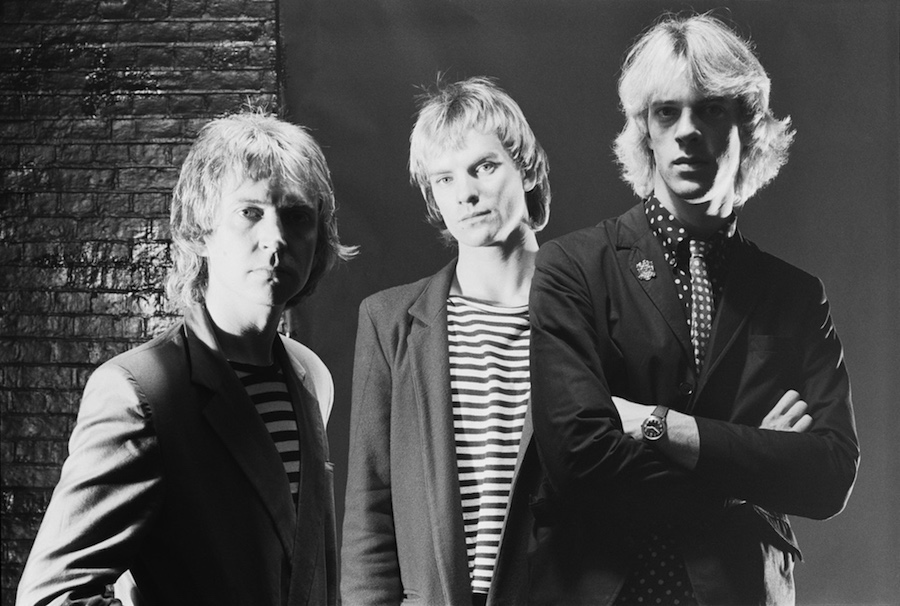If you were to start at the 20-minute mark of the just-released DVD Everyone Stares: The Police Inside Out, you’d think you were watching a friend’s recording of his son’s battle of the bands performance. The sound is muddled, the trio onstage is blurred as the camera struggles to focus, but the band’s chemistry and passion are undeniable. As the camera zooms in you realize you’ve been watching The Police perform “Next to You” at a club in Germany in 1979. Yet, the original impression still applies. 30 years later, Police drummer Stewart Copeland narrates his film like a proud dad watching the kids that he and his bandmates, Sting and Andy Summers, once were. He’s an affable narrator, game and self-deprecating, which is commendable given his perennial placement on nearly every list of the best drummers in rock.
Related: “The Police: 5 Songs That Should’ve Been Singles”
Originally released in 2006, Everyone Stares is less a documentary than it is a document. Nearly every moment of the film was shot by Copeland himself on his 8-millimeter camera that he bought just as the band was starting to experience some success. It reads like postcards and matchbooks collected along the band’s journey from the east coast of the U.S. to the west, from tiny European clubs to amphitheaters, from post-punk obscurity to world domination. There are no talking heads, no rock ‘n roll cliches, just the band’s story told from the inside out.
In one gorgeous shot, Copeland has set the camera onstage just behind him. As he addresses it over his shoulder, under the glow of a celestial blue light, it’s obvious how much a drum kit makes a cage around a drummer, separating him from his bandmates, who mostly have their backs to him when they’re not moving freely. He is at once at the center of it all, and yet just outside of it, observing. In this way, it makes sense that the drummer would appoint himself the documentarian of his band and keep the beat of daily life.
Similarly, the camera creates a barrier between himself and the attention that proves increasingly bothersome to him. In a scene that brings the doc’s title (a reference to Copeland’s song “Does Everyone Stare?” from Regatta de Blanc), Copeland records, from inside a car, a throng of fans who surround the car peering in the windows as it slowly makes its way out onto the street. Eerily, the only sound is the fans’ grasping hands brushing against it. It’s like a scene from The Birds.
There is something refreshing and immediate about this amateur footage. Shadows fall on people’s faces, they move in and out of light, would-be moments are lost as the camera gets fumbled in a rush. More often than not, the film makes fame look like no more than an awkward stare down, a fire hazard, a logistical nightmare. And yet, the dated film quality also creates a certain distance, which appropriately gives the effect of dreamy memory. Unlike HD technology, which insists on letting the viewer feel like they are “right there,” this film reminds us that it was Copeland who was there, all those years ago. These moments belong to him.
There is little sign of the band’s infamous tensions. From his vantage point, Copeland graciously recognizes then-26-year-old Sting’s ideas as “…brilliant, but more and more, we’re stuck with them, and he’s liking it less and less when we mess with them.”
Related: “Performing on ‘SNL’ With Sting”
He sums up the band’s breakup thusly, in one of several sweetly goofy rhymes: “Hollywood’s knocking on Sting-o’s door, Andy wants to play with his cameras more, and I want to know what this life is for.”
“When you get to where you’re going,” he says, “The ride is over.”
Beyond the scenes that show the band at their tightest and the consistently mesmerized crowds, you will see travel footage from a world that’s become unrecognizable. You will see some lovely experimental flourishes where the sailboats on the harbor look like a Renoir painting in motion and that, subliminally, comment on the isolating nature of fame and life on the road, how it can warp one’s perspective, making big things seem tiny and vice versa. “Every now and then I look over my shoulder, and I see a pyramid or a parthenon or some other wonder of the world,” he says, “But my real job is the camera in front of me.”
Mostly you’ll see a lot of the band and their immediate crew just hanging out and being silly, whiling away the hours, staving off boredom with their mates. As many of us come to realize years on, these are the moments that end up mattering the most in the end.
With such a rare and accomplished life to look back on, Copeland is to be applauded for his humility and lack of sentimentality.
This movie is a personal scrapbook, and we’re lucky to get a peek inside.
-Marybeth Connaughton
Photo Credit: The Police (guitarist Andy Summers, bassist and singer Sting, and drummer Stewart Copeland), pose for a portrait, United Kingdom, circa 1979. (Photo by Fin Costello/Redferns/Getty Images)




0 comments on “The Police: “Everyone Stares””